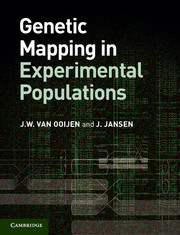Book contents
- Frontmatter
- Contents
- Preface
- 1 Introduction
- 2 Meiosis and genetic recombination
- 3 Estimation of recombination frequencies
- 4 Determination of linkage groups
- 5 Estimation of a genetic map
- 6 Criteria for the evaluation of maps
- 7 How to find the best map order
- 8 Outbreeding species
- 9 Mapping in practice
- Answers to exercises
- Index
- References
4 - Determination of linkage groups
Published online by Cambridge University Press: 05 August 2013
- Frontmatter
- Contents
- Preface
- 1 Introduction
- 2 Meiosis and genetic recombination
- 3 Estimation of recombination frequencies
- 4 Determination of linkage groups
- 5 Estimation of a genetic map
- 6 Criteria for the evaluation of maps
- 7 How to find the best map order
- 8 Outbreeding species
- 9 Mapping in practice
- Answers to exercises
- Index
- References
Summary
Genes and markers on the same chromosome have a linear arrangement, which can be described by a (linear) map. Genes and markers on different, non-homologous chromosomes are inherited independently and therefore there is no linear arrangement between them. This is the reason why genetic linkage maps are estimated separately for each chromosome. Determining which genes and markers belong to the same chromosome is therefore a necessary preparation for map construction. Sets of linked loci are called linkage groups. Ideally, the number of linkage groups is the same as the haploid number of chromosomes. In practice, this is not always the case. Sometimes, the set of loci studied does not cover the entire genome or is not distributed evenly across the genome. On other occasions, spurious linkage causes loci from separate chromosomes to end up in a single linkage group, which is a more common problem to solve.
Why determine linkage groups and how?
Chromosomes are very large linear molecules. Genes and genetic markers are, or represent, tiny parts of the chromosomes. They are referred to as loci. Their linear arrangement on the chromosomes can be described with mutual distance measures, for instance in base pairs or in recombination units. A linkage map is such a description. Because a linear arrangement exists only for loci of the same chromosome, determining which loci reside on the same chromosome is the first step in the construction of a linkage map. Loci on the same chromosome are physically linked, whereas those on different (non-homologous) chromosomes are physically unlinked. Genetic linkage is the phenomenon whereby traits have a tendency to be inherited together. Due to independent assortment of the chromosomes in meiosis, genetic linkage is the result of physical linkage. Determining whether two loci are genetically linked is the starting point of lumping loci into groups. It is preferable to identify such groups of linked genes and markers as linkage groups rather than as chromosomes, as long as the physical relationship between the loci and the chromosomes is not established (e.g. through cytogenetics). This is even more relevant if there are more groups than homologous chromosome pairs. Such situations often occur in experiments where the genome is not covered completely with markers.
- Type
- Chapter
- Information
- Genetic Mapping in Experimental Populations , pp. 45 - 58Publisher: Cambridge University PressPrint publication year: 2013



